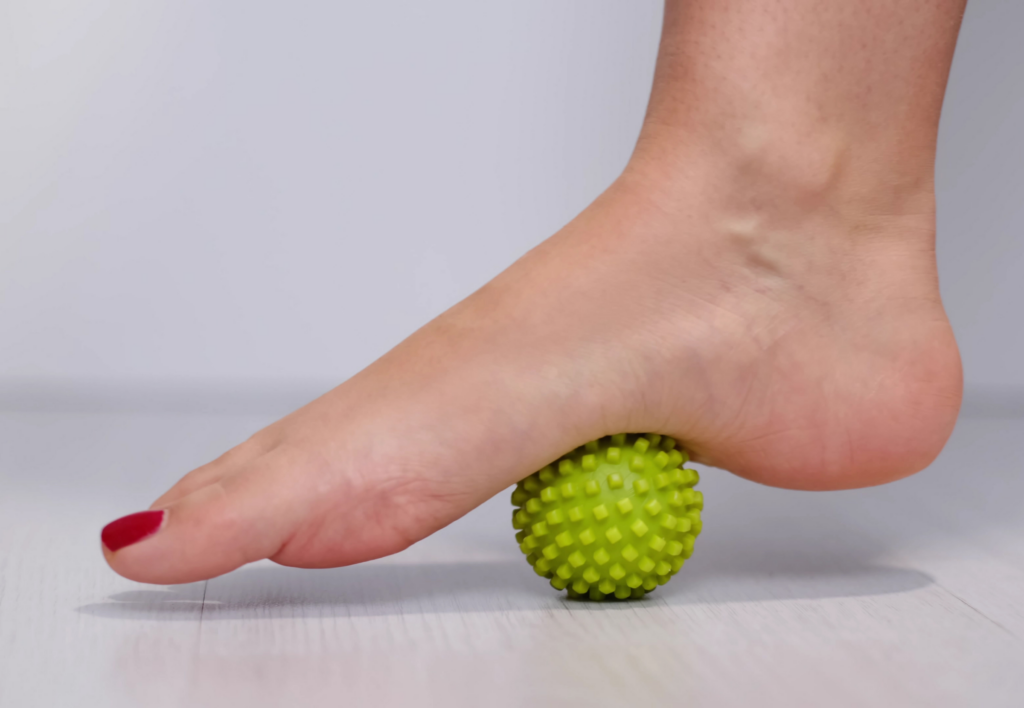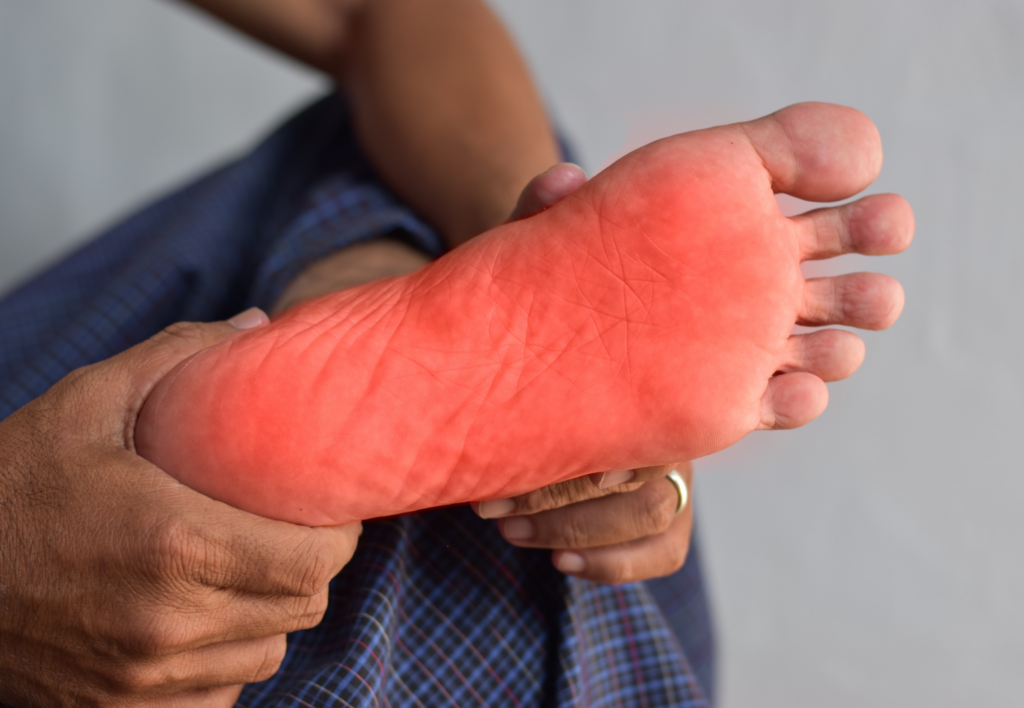Running Warm-Up for Plantar Fasciitis: Key Routine, Stretches, and Exercises
Plantar fasciitis is a common concern for runners, characterized by a sharp pain in the heel and arch of the foot. The condition stems from the inflammation of the plantar fascia, a thick band of tissue running across the bottom of your foot.
When it comes to running with plantar fasciitis, it is crucial to start with an appropriate warm-up routine to prevent further aggravation.
Your warm-up should specifically target the foot and ankle muscles to improve their strength and flexibility. This includes exercises that gently stretch the plantar fascia, Achilles tendon, and calf muscles, as tightness in these areas contributes to the pain associated with plantar fasciitis. Engaging in low-impact activities such as cycling or swimming can also maintain fitness levels while allowing your feet to heal.
Incorporating myofascial release techniques, such as rolling your foot over a massage ball, can further aid in loosening the plantar fascia. It’s important to listen to your body and modify your running routine to include these specific exercises, ensuring a safe and pain-reduced continuation of your training.
Warm-ups tailored for plantar fasciitis are not only preventative but also therapeutic, helping to speed up recovery for those already affected by the condition.
How To Warm Up for a Run With Plantar Fasciitis (15 Minutes)
To begin your running warm-up when dealing with plantar fasciitis, focus on gentle stretching and mobility exercises that target your feet and calves.
When warming up for a run with plantar fasciitis, it’s important to gently prepare your feet and the surrounding muscles without putting undue stress on the inflamed plantar fascia.
Here’s a step-by-step routine with recommended times for each activity:
1. Gentle Foot Roll (2 minutes)
- Sit down and place a tennis ball or frozen water bottle under your foot.
- Slowly roll your foot over the object, applying gentle pressure to massage the arch of your foot.
- Spend about 1 minute on each foot.
2. Toe Stretches (2 minutes)
- While seated, extend your legs and reach forward to pull your toes back towards your body.
- Hold the stretch for 30 seconds and release.
- Repeat 2 times for each foot.
3. Calf Stretch (2 minutes)
- Stand facing a wall with your hands at eye level.
- Place the leg with the affected foot behind you, heel on the ground, and the other leg in front with a bent knee.
- Lean into the wall until you feel a stretch in the calf of the back leg.
- Hold for 30 seconds and switch legs.
- Repeat 2 times for each leg.
4. Achilles Tendon Stretch (2 minutes)
- From the same position as the calf stretch, bend your back knee while keeping your heel on the ground.
- Hold for 30 seconds and switch legs.
- Repeat 2 times for each leg.
5. Ankle Circles (1 minute)
- Lift one foot off the ground and rotate your ankle 10 times in each direction.
- Switch feet and repeat.
6. Towel Scrunches (2 minutes)
- Sit with your feet flat on the ground and place a towel under them.
- Use your toes to scrunch the towel towards you, then push it away.
- Continue for 1 minute per foot.
7. Seated Plantar Fascia Stretch (2 minutes)
- Sit down and cross one leg over the other.
- Use your hand to gently pull the toes back toward your shin, stretching the plantar fascia.
- Hold for 30 seconds and switch feet.
- Repeat 2 times for each foot.
8. Walking Warm-Up (4 minutes)
- Begin with a slow walk, gradually increasing your pace to a brisk walk.
- Focus on rolling through the entire foot from heel to toe.
Total Time: ~15 minutes
During your run, try to maintain a moderate pace and avoid hills or uneven surfaces that could aggravate your plantar fasciitis. After your run, cool down with some gentle stretching and consider icing your foot to reduce inflammation.
Always consult with a healthcare provider or physical therapist for personalized advice and to ensure that you’re not exacerbating the condition.
Dynamic Stretching for Plantar Fasciitis
Dynamic stretching can be highly beneficial for those suffering from plantar fasciitis. The key is to enhance flexibility and mobility in the feet and lower legs before running. Start by focusing on the movement of your feet.
- Toe Walks: Stand on your toes and walk forward for 20 seconds, engaging your calf muscles.
- Heel Walks: Lift your toes off the ground and walk on your heels to strengthen your ankle dorsiflexors.
Incorporating ankle mobility exercises is also crucial:
- Ankle Circles: Rotate your ankles clockwise and then counterclockwise, 10 times in each direction.
- Alphabet Tracing: Use your big toe to ‘write’ letters in the air, moving only your ankle.

Leg exercises to perform:
Calf Raises:
- Stand with feet hip-width apart.
- Push through the balls of your feet to raise your heel as high as possible.
- Slowly lower back down.
- Repeat for 8-10 reps.
Side Lunges:
- Start with both feet forward.
- Step to the right, bend your right knee, and send hips back.
- Keep your left leg straight and chest lifted.
- Hold the lunge briefly, then return to the start position.
- Repeat on the other side.
Perform these stretches as a circuit, aiming for two to three sets prior to your run. They can help to prepare your muscles for the activity and may reduce the risk of plantar fasciitis pain during your workout. Remember to progress gradually, listening to your body’s signals.
Focused Foot Mobilization for Plantar Fasciitis
If you’re facing plantar fasciitis, targeted foot exercises can help alleviate pain and improve mobility. These exercises are designed for direct application and are easy to incorporate into your daily routine.
Foot Rolling:
- Tool: Use a foam roller or a frozen water bottle.
- Method: Place the tool under your foot.
- Action: Roll it back and forth from your heel to your toes.
- Duration: Perform for 2-3 minutes per foot.
Toe Stretches:
- Position: Sit with your affected foot over your opposite thigh.
- Action: Gently pull your toes back towards your shin.
- Hold: Maintain the stretch for 30 seconds.
- Repetitions: Do this 3 times per foot.
Calf Drops:
- Position: Stand on a step with your heels hanging off.
- Movement: Slowly lower your heels below the step level.
- Rise: Lift back to the starting position.
- Repetitions: Aim for 10-15 repetitions.
Remember, consistency is key. Regular performance of these exercises can lead to better outcomes and may allow for a more comfortable running experience.

What Is Plantar Fasciitis?
When your heel aches with every step, you might be facing a common runner’s ailment: plantar fasciitis. This section breaks down its causes, symptoms, and how it affects your running routine.
Symptoms and Causes
Plantar fasciitis typically triggers a sharp, stabbing pain in the bottom of your foot near the heel. This discomfort often occurs when you take your first steps in the morning or after prolonged periods of rest. The primary offender is inflammation of the plantar fascia, a band of tissue that connects your heel bone to your toes and supports the arch of your foot.

Common causes include:
- Excessive strain: Overuse from activities like running can lead to micro-tears and subsequent swelling of the plantar fascia.
- Biomechanical issues: Flat feet, high arches, or abnormal gait can put extra stress on the plantar fascia.
- Tight tendons: A tight Achilles tendon can exacerbate the strain on your plantar fascia.
- Improper footwear: Shoes without adequate support can increase the risk.
Impact on Running
Running with plantar fasciitis can be challenging due to the repetitive impact on an already inflamed and sore area. The continual pounding can aggravate the plantar fascia, potentially leading to more significant damage and extended recovery times if not managed carefully.
Considerations for runners include:
- Surface selection: Running on softer surfaces can reduce the impact on your heels.
- Footwear: Ensure you’re running with shoes that provide proper arch support and cushioning.
- Warm-up routines: Perform exercises to improve tendons and ligaments’ elasticity and decrease morning pain.
Managing plantar fasciitis involves:
- Rest: Reducing running frequency to allow time for the inflamed tissue to heal.
- Strengthening exercises: To support and stabilize the arch and alleviate stress on the plantar fascia.
- Proper stretching: Focusing on the Achilles tendon and plantar fascia to maintain flexibility and reduce tightness.
Injury Prevention Strategies
Managing plantar fasciitis involves specific methods to alleviate stress on your feet, ensuring continued running without exacerbating the condition. Focus on the right footwear and adequate rest, paired with cross-training to protect and strengthen your feet.
Proper Footwear and Orthotics
Selecting the correct running shoes is critical to reduce injuries and provide arch support, especially if you have flat feet or high arches. Consider these features:
- Arch Support: Vital for individuals with flat feet or high arches to prevent overpronation.
- Cushioning: Aids in absorbing impact and reducing stress on the heel and plantar fascia.
- Fit: Shoes should fit well to avoid excessive movement that could strain the fascia.
If standard running shoes don’t provide sufficient support, consult a podiatrist about custom orthotics. Your weight and BMI are factors to discuss, as they can influence the type of support you need.
Cross-Training and Rest Days
Incorporating cross-training into your routine can enhance strength, helping to prevent overuse injuries. Essential practices include:
- Strengthening Exercises: They bolster foot musculature, which supports the arch and can mitigate strain on the plantar fascia.
- Rest Days: Essential for recovery, rest days allow the plantar fascia time to heal and regenerate.
Schedule regular rest days and consider low-impact activities such as swimming or cycling on cross-training days to maintain fitness without putting additional stress on your feet.
Treatment and Rehabilitation
When you’re dealing with plantar fasciitis, an effective treatment plan focuses on reducing foot pain and discomfort. Let’s look at the step-by-step treatments and rehabilitation strategies that support recovery.
Conservative Treatments
Initial Relief:
- Ice therapy: Apply a cold pack or roll your foot over a frozen water bottle for 15-20 minutes several times a day to reduce inflammation.
- Stretch and Massage: Gently stretch your calf and plantar fascia. Using a lacrosse ball or similar object, massage the bottom of your foot to alleviate tightness.
Supportive Actions:
- Taping: Athletic taping can provide support to the foot, relieving stress on the plantar fascia.
- Night Splint: Using a night splint keeps your foot in a flexed position overnight, aiding in morning discomfort relief.

Exercise and Strengthening:
- Calf Raises: Perform calf raises to strengthen the muscles around your foot and improve circulation.
- Swimming: Engage in low-impact activities like swimming that don’t put excess pressure on your feet.
Physical Therapy:
- Consult a physical therapist for a personalized treatment plan that includes exercises tailored to your injury.
Advanced Therapies
Non-invasive Treatments:
- Cortisone Injections: For persistent pain, cortisone injections can be administered by a healthcare professional to reduce inflammation.
Surgical Consideration:
- Surgery is considered a last resort and is only recommended if other treatment options have not provided relief.
Rehabilitation Focus:
- Post-treatment or surgery, dedicated rehabilitation with physical therapy is crucial to regain full function and prevent future injury.






